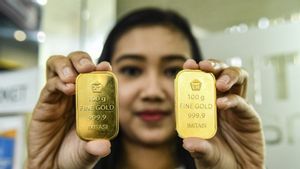The Ministry of Industry (Kemenperin) admits that it is considering providing additional incentives for hybrid cars or hybrid electric vehicles (HEVs) because they are able to reduce carbon emissions by up to 49 percent based on the calculation of emissions from gasoline tanks to exhausts.
The Director General of Metal, Machinery, Transportation Equipment and Electronics (ILMATE) of the Ministry of Industry, Taufiek Bawazier, said that the basis for providing incentives is carbon emissions issued by HEV, which is lower in emissions, so hybrid cars deserve incentives, even though their form has not yet been formulated.
"Actually, we have initiated, the analysis going forward until 2060 is carbon reduction, which means that what is measured is how much industry or manufacturing produces a product that is able to reduce carbon emissions," he said in a discussion on Forwin entitled Otomotif, Ujung Tombak Decarbonization Indonesia in Jakarta, quoted from Antara, Wednesday 9 August.
Taufiek said that if certain types of vehicles are able to reduce carbon emissions from the specified threshold, then the vehicle must get a reward or incentive.
This is similar to what is applied in Europe where the emission reduction threshold is 95 grams per km. As for Indonesia today, according to Taufiek, there is already an HEV model with an emission reduction of up to 75 grams per km.
Taufiek said that in order to be able to apply incentives for hybrid cars, the government needs to conduct a kind of survey to record each product to then determine the average threshold that can be used as a reference for reducing emissions.
"We don't know exactly what company A, B, C, D, products we need to census of every company product A, B, C, D, he has a product and an average threshold that we can use for the national world like and what we benchmark with other countries," he said.
According to Taufiek, in Government Regulation (PP) Number 74 of 2021 concerning Amendments to Government Regulation Number 73 of 2019 concerning Taxable Goods Classified as Luxury in the Form of Motorized Vehicles Subject to Sales Tax on Luxury Goods, both battery-based electric vehicles (BEVs) for hybrid cars (HEVs) or Plug In Hybrid Electric Vehicles (PHEVs) have received incentives.
"If you look at the interest, maybe we should give you a hybrid, but the gift has a basis. The basis for giving I think (based on) carbon. But it is necessary to provide the right way so that we are not protested to provide subsidies to rich people and all kinds of things," he said.
On the same occasion, University of Indonesia's LPEM Automotive Observer Riyanto said that currently selling one BEV unit is more difficult than two HEV units. Even though the reduction in emissions of two HEV units is said to be equivalent to a reduction in one BEV unit.
"Currently, BEV gets BBN and PKB incentives. I think this can be considered into a "hybrid" because it can reduce emissions by up to 50 percent. So, hybrid cars deserve additional incentives," he said.
According to Riyanto, hybrid cars are more suitable for use in the transition era to carbon neutrality by 2060. This is because the price of electric cars is still high in the range of Rp600-700 million, which is still very small.
With a budget of Rp. 200-300 million, it is likely that consumers will prefer conventional cars with a capacity of seven passengers.
Meanwhile, the price of hybrid cars with a capacity of seven and five passengers is currently closer to conventional car prices, so it is considered reliable to reduce emissions in the transition era.
"BEV can indeed reduce emissions according to the government's target. However, can the volume of BEV sales be in line with the government's target to reduce emissions?" he said.
Similarly, the General Secretary of the Association of Indonesian Automotive Industries (Gaikindo) Kukuh Kumara said that EV development was indeed predicted as one of the efforts to get to net zero emissions.
اقرأ أيضا:
However, going to net zero emissions is not just using EVs. For EVs there are stages, options provided ranging from HEV, PHEV to BEV and other alternatives such as fuel cell electric vehicles," he said.
In 2021, Gaikindo noted that BEV and HEV sales were not very significant because the pattern of public adoption of vehicle electrification was still low. As for 2022, sales of electrification vehicles jumped to 10 thousand units and are expected to continue to increase.
However, said Kukuh, Indonesians are very sensitive to prices so that as long as prices are still affordable, consumers will buy. This will greatly affect industrial productivity.
Despite its significant growth, the development of EVs, he said, must be accompanied by the provision of options for the community because the main goal targeted is to reduce emissions.
Kukuh said that so far Indonesia has known ethanol, biofuel, and biosolar.
"To go to net zero emissions or decarbonization does not only depend on EVs, but in Indonesia we have several other choices," said Kukuh.
The English, Chinese, Japanese, Arabic, and French versions are automatically generated by the AI. So there may still be inaccuracies in translating, please always see Indonesian as our main language. (system supported by DigitalSiber.id)
















